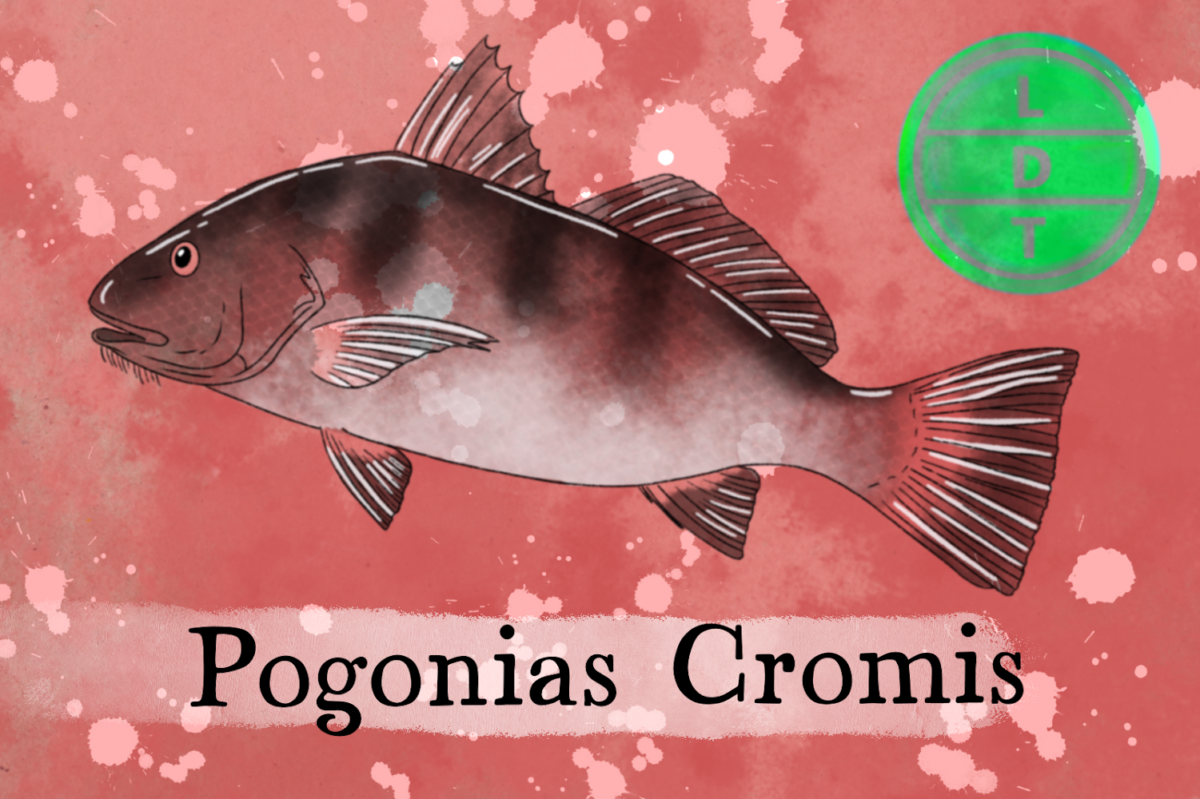“…and today we’re talking about a percussive Pisces. But more on that later.”
If you live in the suburbs of Tampa Bay, Florida. You may have heard an eerie sound in the night. As you drift off to dreamland, you not only hear a strange low rumbling, you can feel it in your chest. As you sit up, you realize your windows are shaking. The dog across the street starts barking. You run to the window, but there’s nothing there, and you can’t tell where the sound is coming from, but it’s all around you. The black drumfish is the watcher in the water, the drums in the deep and they are coming, in Life, Death, and Taxonomy.
Description of the Black Drumfish
- Large cylindrical body with a dark gray to blackish coloration – kinda has the shape of a snapper
- vertical stripes or bars along its sides
- Large, fleshy lips for bottom feeding
- Rounded teeth and powerful jaw for crushing mollusc shells
- Little spines along the lower jaw
- Blunt, rounded snout and a high, arched back
- Its dorsal fin is long and has multiple spines along the length
Measure Up
Welcome to the beloved Measure Up segment. The official listener’s favorite part of the show! The part of the show when we present the animal’s size and dimension in relatable terms through a quiz that’s fun for the whole family. It’s also the part of the show that’s introduced by you when you send in audio of yourself saying, singing, or chittering the words Measure Up into ldtaxonomy at gmail dot com. We don’t have a new Measure Up intro!
Length
- The black drumfish typically grows from 12 to 24 inches (30 to 61 cm) in length as they mature. They can reach a maximum length of about 67 inches (170 cm).
- How many drumfish go into the length of the Jose Gasparilla II?
- Hint: The Jose Gasparilla II is a pirate ship that is used in a Tampa Bay festival that shares its name. The festival celebrates the mythical pirate Gaspar, and the real history of piracy in Tampa.
- 68.5 fish. This ship is actually a flat bottom barge of 137 feet in length.
Weight
- 5 to 30 pounds (2.3 to 13.6 kg)
- However, they can grow significantly larger, with the largest recorded black drum weighing just over 113 pounds (51 kg).
- How many drumfish go into the weight of the largest drum?
- Hint: The largest drum instrument, known as the CheonGo, was built by Yeong Dong-Gun local government and Seuk Je Lee in Simcheon-Meon, South Korea.
- 466.67 fish. The drum is 7 tonnes (15,432 lb 5.76 oz).
Fast Facts about the Black Drumfish
- Range: In the western Atlantic, black drum are found from Nova Scotia to Florida, the Gulf of Mexico, the Antilles), and the southern Caribbean coast. They are common between the Delaware Bay and Florida coasts, and most abundant along the Texas coast.
- Diet: as little tykes, they eat zooplankton. As juveniles, they eat worms. And as adults, they eat molluscs and crabs off the sea floor.
- Their sensitive chin barbels help locate food, and strong pharyngeal teeth crush the shells of these preferred foods.
- Behavior:
- They are regularly fished and served as food
- Oldest known black drum fish was 44 years old
- As juveniles, they are predated on by larger fish
- As adults, they really only have to look out for sharks and fishing rods
- Not too much else other than how to fish these guys
Major Fact: Night Drumming
Last year, Tampa residents reported hearing a low humming bass noise vibrating throughout residential areas. The sound was so loud that it would shake windows and keep people up at night. One resident said, “I hope the cops catch whoever is making that sound before I do.” There were many theories offered, up to and including aliens, but the real answer is almost stranger.
Black drumfish are known for producing distinctive deep sounds, especially during their spawning season. These sounds are created by the contraction of muscles against their swim bladder, which acts like a drum, and the sonic muscle functions as the drumstick. This sound is often referred to as a “drumming” sound due to its similarity to the percussion instrument.
Drumming is used to communicate with black drumfish, establish territories, and attract potential mates. The low-frequency sounds they produce can be very loud and transmit a lot of energy over long distances, ranging from about 60 to 1100 Hz, with most of the acoustic energy concentrated below 400 Hz.
Why do they drum? They usually do it during specific behaviors, such as mating, courtship, or territorial disputes. During the breeding season, male black drumfish create humming sounds to attract females.
These underwater serenades serve as a signal of readiness to mate. The vibrations travel through the water, allowing potential mates to locate each other.
Black drumfish are known to be territorial. The humming sound may also function as a warning to other fish, asserting their presence and claiming a specific area.
Ending: Use your strong beard to eat a boatload of oysters, keep an eye out for sharks, and drop that bass when you’re sweet-talkin’ the ladies like the black drum fish here in LDT.

